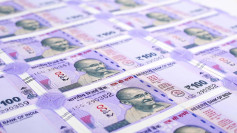[Business Times THK Exclusive Interview] Up until 2009, Chinese Yuan Renminbi (RMB) settlements (CNY) were not permitted outside Mainland China but authorities removed limitations on RMB trade settlements between China and Hong Kong as a step to internationalizing the RMB. This led to the offshore version of the RMB, denoted (CNH) across 30 worldwide RMB markets though "H" originally stood for Hong Kong.
Since the Sino-American trade war started in 2018, the yuan's (CNH) exchange rate against the dollar has become a barometer of the US-China relations. The tensions between the two countries have worsened in May and June of this year. The yuan onshore exchange rate (CNY) dramatically declined and then eased up to stay stable. Major banks continue their concern over the yuan's decline. Goldman Sachs Group Inc. expects USD/yuan rates to reach 7.25 over the next three months versus prior forecasts of 7.15. Hong Kong Business Times (HKBT) invited Qun Liao, the Chief Economist and Research Manager of CITIC Bank, to analyze the yuan fluctuation tendencies and to share his insights into the US-China economic relations.
Goldman Sachs predicts the offshore yuan to fall to a historical low of 7.25 against the dollar within three months
The new US-China tensions in May and June weighed on the yuan currency's rate. The offshore yuan approached the 7.2 mark at the end of May, hitting 7.1964 versus the dollar. The yuan currency's central parity rate against the dollar reached 7.13, the lowest record since February, 2018. With the situation easing up, the offshore yuan will be set to stay below 7.1.
From a broad perspective, risk appetite has increased after China officially resumed production and operation from March and European countries and states across the US are gradually reopening economies. The U.S. Dollar Currency Index, which measures the greenback's strength against six other major currencies, was down to below 97, a level before the global pandemic outbreak in March, which benefits currency flow back to new markets.
However, concerns remain from major banks that China might fail to implement the phase one US-China trade deal and the risk for the yuan to decline is high. Goldman Sachs expects the offshore yuan against the dollar to fall to 7.25 from 7.15 over the three months, the lowest level in decades.
Qun Liao : The yuan currency reflects the worsened US-China relations
Mr. Liao says, "The coronavirus pandemic creates new obstacles for China to implement the phase one US-China trade deal." In the agreement, China promised to purchase various American goods and products in 2020. Only if China's economy recovery speeds up in the second half of the year or arrangement for food storage takes place, will China have a chance to reach the deal's terms.
The yuan currencies against the dollar has been a barometer, reflecting the scenario of US-China relations since the trade war started in 2018.
Mr. Liao comments that as US-China relations have recently worsened, the importance of how bad it will become emerges. By previous experience, the worsening of US-China relations bring increased pressure that the yuan will face depreciation, which is immediately reflected in its exchange rate.
Prediction 1: The onshore yuan may trade in the range of 7 to 7.2 against the dollar within this year.
Mr. Liao indicates that the worst situation would be U.S.-China decoupling, which would affect the global economy itself and currencies around the world, including the yuan.
"In American style, if hammering on China didn't cause domestic economic losses for the U.S., it would surely decouple with China. But the U.S.-China economic ties are based on mutual benefit and common progress. Therefore the economic decoupling won't be the case." Mr. Liao says.
Prediction Two: China has economic growth by 2-3%, while the U.S. has negative growth by 4-6%.
On the whole, Mr. Liao thinks that yuan's onshore exchange rate against the dollar would fluctuate in the range of 7 and 7.2, under the premise of no economic decoupling nor drastically worsened relationship with the U.S. Meanwhile domestically, China's economic recovery proceeds on schedule.
The public have raised concerns about the second wave of infections in the U.S. Mr. Liao comments, regarding the economy recovery, that China has been doing a better job. He predicts China's economic growth across the whole of 2020 will reach 2-3%. He expects the U.S. will likely see 4-6% negative growth.
Prediction Three: Hong Kong's currency could become pegged to the yuan in the long term.
Stuck in the middle of U.S.-China tensions, Hong Kong's economy remains uncertain while some voices suggest Hong Kong's currency should be pegged to the yuan.
"The change is impossible in the short term because the yuan hasn't fully opened yet. Once Hong Kong's currency is pegged to the yuan, the Hong Kong dollar will be supervised. It seems unnecessary at this point." Mr. Liao straightforwardly responds, "Whether Hong Kong's currency is pegged to the U.S. dollar is not an issue of relationship with the U.S., but majorly depends on its foreign exchange reserves." By the end of April, Hong Kong's foreign exchange reserves were up to 441,2 billion U.S. dollars. "Who would want to attack the Hong Kong dollars?" he adds.
In the long term, Hong Kong's currency is likely to be pegged to the yuan. As Hong Kong's economy becomes more connected with the rest of China, pegging Hong Kong's currency to the yuan could become more rational under the premise of the complete convertibility of the yuan.
U.S.-China trade war will likely spiral into a currency war
Chinese Academy of Social Sciences has put forward an opinion that no matter in the real economic field or the international financial field, the Covid-19 pandemic strengthens the "tendency of excluding the Chinese yuan". An "ally" that excludes the yuan and China has been coming into shape.
First evidence was that the central banks of nine countries except for China opened dollar swap lines to ease up the global dollar shortage. Secondly, Libra 2.0, Facebook's virtual currency system, won't be backed by Chinese yuan. As a basket of different currencies, Libra 2.0 constitutes 50% U.S. dollars, Euro 18%, Japanese yen 14%, British pound 11% and Singapore dollar 7%.
Additionally, Federal Retirement Thrift Investment Board paused China investment, the U.S. government tightened supervision over publicly traded companies and passed bills to delist Chinese firms. All kinds of signs are viewed as an "attack" China, which alert the finance sector - the trade war could spread into the finance field and launch a currency cold war of "excluding yuan tendency".
Whether in the traditional currency systems or the new virtual currency systems, Chinese yuan is obviously being isolated, which would certainly affect its currency internationalization.
The yuan moves slowly towards internationalization
Mr. Liao points out the U.S.'s biggest concern is over the yuan's internationalization. If it progresses fast, the U.S. dollar as the leading role in the global currency market would be challenged. For many decades, the dominant dollar has been playing an important role in supporting the strength of the U.S. economy. That explains why the U.S. emphasizes protection on the dollar and keeps dollar value higher.
Mr. Liao says, "Under such circumstances, the yuan has inevitably weakened. Though the process of the yuan's internationalization definitely won't be around the corner, the direction surely won't change."
Disclaimer: The material (including investment strategy and analysis) is for general information purposes only. Nothing in this material is financial, investment or other advice on which reliance should be placed. No opinion given in the material constitutes a recommendation by Business Times or the author that any particular investment, security, transaction or investment strategy is suitable for any specific person.






